Dr. Davis' Courses
Plant Physiological Ecology (Biology 390)
 A study of principal life processes
in higher plants with emphasis on physiological
performance and physiological adaptations of native
plants to a stressful environment. The course will
investigate such topics as plant responses to wildfire,
summer drought, freezing air temperature and nutrient
impoverished soils. The course will also address
important issues dealing with global climate change and
its predicted effects on vegetation patterning.
Physiological ecologists pose three central questions:
why do plants grow where they do? How are they uniquely
adapted to persist were they are found? And how will
native vegetation respond to predictions of climate
change? The study of plant physiological ecology is
demanding and exciting. The multitude of environmental
changes in progress, both abiotic and biotic, their
spatial and temporal patterns, and their potential
interactions yield an abundance of scientific questions
to be pursued. The rich diversity of species and varied
habitats of southern California are especially conducive
to this field of study.
A study of principal life processes
in higher plants with emphasis on physiological
performance and physiological adaptations of native
plants to a stressful environment. The course will
investigate such topics as plant responses to wildfire,
summer drought, freezing air temperature and nutrient
impoverished soils. The course will also address
important issues dealing with global climate change and
its predicted effects on vegetation patterning.
Physiological ecologists pose three central questions:
why do plants grow where they do? How are they uniquely
adapted to persist were they are found? And how will
native vegetation respond to predictions of climate
change? The study of plant physiological ecology is
demanding and exciting. The multitude of environmental
changes in progress, both abiotic and biotic, their
spatial and temporal patterns, and their potential
interactions yield an abundance of scientific questions
to be pursued. The rich diversity of species and varied
habitats of southern California are especially conducive
to this field of study.
"The oecology of plant-distribution will succeed in opening new paths on the condition only that it leans closely on experimental physiology, for it presupposes an accurate knowledge of the conditions of the life of plants which experiment alone can bestow." A.F.W. Schimper (1898) Plant Geography on a Physiological Basis
"The proper task of physiology is the study of the external factors of the environment in which the plant lives, and of the activities and structure which these factors call forth."....."Physiology was originally understood to be an inquiry into the nature of plants. This is the view that pervades the following pages, and in accordance with this subject matter of ecology is merged with that of physiology." F.E. Clements (1907) Plant Physiology and Ecology.
"The objective of Plant Physiological Ecology - explain plant performance, survival and distribution in physiological, biophysical, biochemical, and molecular terms." O.L. Lange (1981) Physiological Plant Ecology I: Responses to the Physical Environment.
"Physiological ecologists address three central problems - 1) reasons for the present geographical distributions of plant populations, 2) definition of the potential tolerance range of plant taxa, and 3) how ecosystems operate in a changing biosphere." W.D. Billings (1985) Physiological Ecology of North American Plant Communities
"Physiological ecologists address ecological questions about the controls over the growth, reproduction, survival, abundance and geographical distribuiton of plants as these processes are affected by the interactions between plants with their physical, chemical, and biotic environment." H. Lambers, F. S. Chapin III and T. L. Pons (1998) Plant Physiological Ecology
Biology of Plants (Biology 213)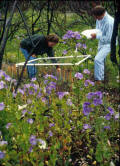
An introduction to the study of plants with emphasis on the morphology, physiology, classification and life history characteristics of higher plants. A survey of lower, more primitive plant forms will also be included. We will examine the structure and function of leaves, stems, roots and flowers. Plant responses to light, gravity, touch, and environmental stress will also be discussed. Emphasis will be placed on plant growth and development, photosynthesis, transpiration, water/nutrient transport and the regulatory role of plant hormones. Short field trips on campus will be taken in virtually every lab period. Intermediate trips will be taken to riparian, oak woodland and coastal marsh habitats. One extended, weekend field trip will be taken along a desert-to-alpine vegetation gradient. Most of the time will be spent in the botany lab examining specimens under the microscope or growing plants under light tables to determine responses to environmental cues (light quality, intensity, duration, direction; positive and negative response to gravity; tolerance to water stress, temperature stress, and chemical stress). All students will do independent research projects, about half of which will be done in the field, the other half in a greenhouse or laboratory
Plants and the Environment (Biology 107)
This course investigates the relationships of plants to the environment, with emphasis on the importance of plants to humans for food, fiber, fuel, and medicine. Emphasis will also be given to the management and preservation of our natural vegetation resources of southern California: coastal marsh, coastal sage scrub, chaparral, conifer forest, desert scrub, and grassland. Both laboratory and local field trips will be heavily employed in this course. Students will work on independent research projects, some of which will be in the field, but most of which will require controlled environments, and permanent experiments set up in a greenhouse or Laboratory. Three lectures and one three-hour laboratory per week.
Plant Ecology:
Sustaining Our Life Support System (GSNS 199.02)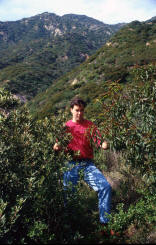
Green plants provide humans with food, fiber, fuel and medicine. They enable animal life through oxygen production, nutrient transformations and solar energy capture. Native plants deter global warming (a major sink for atmospheric carbon dioxide), desertification (they return ground water to the atmosphere) and soil erosion (essential for agriculture). In short -- plants sustain our life support system on earth. This seminar will focus on our plant natural resources, utilizing examples found in the Santa Monica Mountains and coastal regions near the Malibu campus. We will not only examine current problems of environmental degradation but will emphasize possible solutions through wise management practices, formulated through the scientific principles of plant ecology. The challenge for ecologists is to determine "how nature works" -- the challenge for policy makers is "how to integrate this knowledge into economic and cultural realities for a sustainable future." Our ultimate goal is to learn how to best "care for" the local ecosystems that sustain our lives. We want to think "globally but act locally." Although this freshman seminar course does not have a formal laboratory section, we will take field trips to local habitats (barrier beach, coastal marsh, coastal dune, coastal bluff, riparian, coastal strand and chaparral plant communities).
Tropical Forest Ecology of Costa
Rica (Biology 592)
The objective of this course is to introduce the complex interactions of organisms with their environment in the tropical-moist, tropical-rain and tropical-cloud forests of Costa Rica. Emphasis will be placed on utilizing the scientific method to understand how forest ecosystems work and the application of this knowledge to sustain forest ecosystem function. The combined efforts of majors in biology with non-majors will uniquely illustrate the connections between scientific discovery and scientific application. The challenge for scientists is to determine "how nature works in the tropics" -- the challenge for policy makers is "how to integrate this knowledge into economic and cultural realities for wise management practice." Our ultimate goal is to learn how to best "care for" the tropical forests that sustain our lives.
Summer Undergraduate
Research in Biology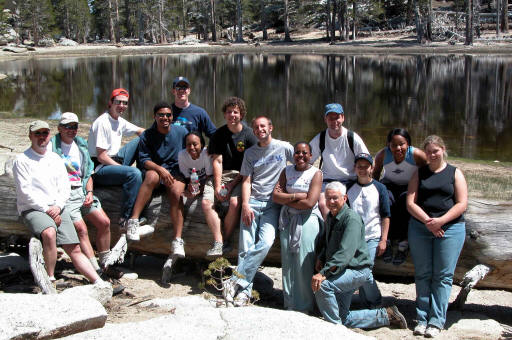
The Ecology of Chaparral: Adaptations
to Drought, Wildfire, and Freezing
The chaparral shrub community of southern California occurs in a Mediterranean-type
climate region characterized by an unusually consistent summer rainless
period, often 6 to 8 months in length. Evergreen shrubs may dehydrate
far below the water stress levels that typically cause crop plants to
wilt (~-1.5 MPa) and die (~ -3.0 MPa). Many chaparral species dehydrate
below – 10 MPa and avoid dysfunction of their water transport system
(xylem conduits) by having stem xylem that is extremely resistant to embolism
(formation of gas bubbles that block water transport). Thick, nearly impenetrable
stands of evergreen chaparral shrubs accumulate fuel with age and are
especially combustible during extreme weather events in late fall. Chaparral
species are not killed by fire but are rejuvenated by fire. Many species
require a fire cue for seed germination and shoots incinerated by fire
are quickly replaced by vegetative re-sprouts from a basal burl. Chaparral
species at inland valleys, away from the coastline, may experience winter
nighttime temperatures of -10 to -12 C, which kills some species but not
others. Differential susceptibilities of chaparral species to drought,
wildfire, and freezing are consistent with plant distribution patterns.
There is growing evidence of interactions among physiological susceptibility
to drought, wildfire, and freezing as a suite of factors that determine
final community structure and diversity of California’s dominate
vegetation type. Understanding these interactions has increased significance
because California’s plant communities represent one of the world’s
“hot spots” of biological diversity.
Wildfire
We who chose to live at the urban-wilderness interface in southern California also chose to live with recurrent wildfire as a natural ecosystem process. We must not only respect the destructive capacity of wildfire and be prepared for such events, we must also learn to appreciate the important benefits of fire. Many indigenous species of plants are "fire dependent" -- their seeds do not germinate and they do not thrive without fire. Some seeds only germinate after detecting smoke from burning wood. Many species vigorously resprout after shoots are consumed by flames. From an ecological perspective, local ecosystems are not "destroyed" by fire but require fire for "renewal" and "rejuvenation". Wildfire increases plant vigor, promotes recycling of nutrient resources, increases biodiversity, reduces the numbers of exotic (weed) species, and favors productivity. The services rendered by the native plants that carpet the hillsides above our homes are numerous and are provided at low cost to humans. These native plants deter soil erosion, increase slope stability, return soil water to the atmosphere, provide cover and food for wild animals, are aesthetically pleasing, offer recreational activities, yet require no irrigation, clipping, or fertilizer. Our studies indicate that some shrub species (eg. Malosma laurina) have rooting depths in excess of 44 feet and thus not only stabilize soils but deter major land slides. Other species (eg. Ceanothus megacarpus) are among the most drought tolerant of all plants and thus provide a low maintenance, drought resistant xeroscape and a genetic storehouse for the breeding of plants for water conservation. Many species are nitrogen fixers that help fertilize what is normally nutrient impoverished soils.
Selected publications (* denotes undergraduate student):
- Witter, M., R.S. Taylor, and S.D. Davis. 2007. Fire history and vegetation response to wildfire in the Santa Monica Mountains, California. Crossosoma. In: Flora and Ecology of Santa Monica Mountains: Proceedings of 32nd Annual Southern California Botanists Symposium. D. A. Knapp (Ed.). Page 173-194. Southern California Botanists Special Publication No. 4, Fullerton, California.
- *Jacobsen, A.L., S.L. Fabritius and S.D. Davis. 2004. Fire frequency impacts non-sprouting chaparral shrubs in the Santa Monica Mountains of southern California. In Ecology, Conservation and Management of Mediterranean Climate Ecosystems, Margarita Arianoutsou and Vasilios P. Papanastasis (Eds.). Proceedings of 10’MEDECOS. Millpress, Rotterdam, ISBN 90 5966 016
- Davis, S.D, *K.J. Kolb and *K.P. Barton. 1998. Ecophysiological processes and demographic patterns in the structuring of California chaparral. In: Rundel. P. W., G. Montenegro, and F Jaksic (eds.) Landscape Disturbance and Biodiversity in Mediterranean-Type Ecosystems. Springer Verlag, Berlin. 136: 297-310
- *Pratt, S.D., *A.S. Konopka, M.A. Murry, F.W. Ewers and S.D. Davis. 1997. Impact of water relations on the nodulation frequency of post-fire seedlings of Ceanothus spp. growing in the Santa Monica Mountains of southern California. Physiologia Plantarum. 99:673-679.
- Williams, J.E. , S.D. Davis and *K.A. Portwood. 1997. Xylem embolism in seedlings and resprouts of Adenostoma fasciculatum after fire. Australian Journal of Botany. 45:291-300.
- *Saruwatari, M.W. and S.D. Davis. 1989. Tissue water relations of three chaparral shrub species after wildfire. Oecologia (Berlin).80:303-308.
- *Thomas, C.M. and S.D. Davis 1989. Recovery patterns of three chaparral shrub species after wildfire. Oecologia (Berlin). 80:309-320.
- *Frazer, J.M. and S.D. Davis. 1988. Differential survival of chaparral seedlings during the first summer drought after wildfire. Oecologia (Berlin) 76:215-221.
- *DeSouza, J., *P. Silka, and S. D. Davis. 1986. Comparative physiology of burned and unburned Rhus laurina after chaparral wildfire. Oecologia (Berlin) 71:63-68.
Drought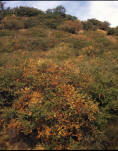
The survival and growth of woody plants in dryland regions of the United States depends on their ability to withstand tissue dehydration during drought. It is particularly important that the cells specialized in transporting water (xylem vessels) from the soil to leaves remain functional and that the water column not be disrupted by air bubbles (embolism). In higher plants the introduction of air bubbles into xylem vessels results in a blockage of water transport and, if extensive enough, kills the plant. Laboratory experiments indicate that one of the major causes of xylem embolism is severe water stress during extended periods of drought. However, very little is known about the occurrence and significance of embolism in nature. There are two genera of chaparral shrubs in California (Arctostaphylos and Ceanothus) that contain species with very different life history characteristics - sprouters and non-sprouters after wildfire. Non-sprouters were hypothesized to be more tolerant of the first summer drought after wildfire and thus more resistant to water stress-induced embolism of their xylem tissue. This hypothesis was tested by comparing three pairs of co-occurring sprouters and non-sprouters of Ceanothus. In all cases, non-sprouters had significantly greater resistance to water stress-induced embolism than sprouters (differences ranged between 2.5 and 3.7 MPa in water potential were 50% embolism occurred). When vulnerability to xylem embolism was compared among four dominant species of a mixed chaparral stand, susceptibility to water stress-induced embolism varied between -11 MPa for Ceanothus megacarpus to -1.9 MPa for Malosma laurina. Adenostoma fasciculatum (-8.3 MPa) and A. sparsifolium (-5.9 MPa) were intermediate. The increasing order of susceptibility to embolism (C. megacarpus < A. fasciculatum < A. sparsifolium < M. laurina) corresponded to the order in which post-fire seedlings were susceptible to summer drought: C. megacarpus (63% survival), A. fasciculatum (21% survival), A. sparsifolium (8% survival), and M. laurina (1.1% survival). A comparison of the vulnerability of xylem to embolism among 22 species of chaparral shrubs indicated that susceptibility corresponds to minimum seasonal water potentials but is weakly correlated with vessel diameter or area specific conductivity. This is consistent with the hypothesis that susceptibility to water stress-induced embolism is a function of pore size in pit membranes of vessel and tracheid cell walls and not vessel size.
Selected publications (* denotes undergraduate student):
- Jacobsen, A.L., R.B. Pratt, S.D. Davis, and F.W. Ewers. 2007. Cavitation risistance and seasonal hydraulics differ among three arid Californian plant communities. Plant, Cell and Environment 30:1599-1609.
- Pratt, R.B., A.L. *Jacobsen, K. *Golgotiu, J.S. Sperry, F.W. Ewers, S.D. Davis. 2007. Life history type and water stress tolerance in nine California chaparral species (Rhamnaceae). Ecological Monographs. 77:239-253.
- Pratt, R.B., A.L. *Jacobsen, F.W. Ewers, and S.D. Davis. 2007. Relationships among xylem transport, biomechanics and storage in stems and roots of nine Rhamnaceae species of the California chaparral. New Phytologist 74:7787-798.
- Jacobsen, A.L., L. Agenbag, K.J. Esler, R.B. Pratt, F.W. Ewers, S.D. Davis. 2007. Xylem density, biomechanics and anatomical traits correlate with water stress in 17 evergreen shrub species of the Mediterranean-type climate region of South Africa. Journal of Ecology. 95:171-183.
- *Jacobsen, A.L., R. Brandon Pratt, F.W. Ewers, and S.D. Davis. 2007. Cavitation resistance among twenty-six chaparral species of southern California. Ecological Monographs. 77:99-115.
- *Jacobsen, A.L., F.W. Ewers, R.B. Pratt, W.A. Paddock III, S.D. Davis. 2005. Do xylem fibers affect vessel cavitation resistance? Plant Physiology. 139:546-556.
- Koch, G.W., S.C. Sillett, G.M. Jennings, S.D. Davis. 2004. The limits of tree height. Nature. 428:851-854.
- Baas, P., F.W. Ewers, S.D. Davis and E.A. Wheeler 2004 Evolution of xylem physiology. In: Evolution of Plant Physiology, Imogen Poole and Alan R. Hemsley (Ed.). Linnean Society Symposium Series number 21, Elsevier Ltd., Oxford, UK: 273-295.
- Davis, S. D., F. W., Ewers, J. S. Sperry, *K. A. Portwood, *M. C. Crocker, and G. C. Adams 2002. Shoot dieback during prolonged drought in Ceanothus chaparral of California: a possible case of hydraulic failure. American Journal of Botany. 89:820-828.
- Davis, S.D., F.W. Ewers, *J. Wood, *J.J. Reeves. and *K.J. Kolb. 1999. Differential susceptibility to xylem cavitation among three pairs of Ceanothus species in the Transverse Mountain Ranges of Southern California. Ecoscience 6:180-186
- Davis, S.D, *K.J. Kolb and *K.P. Barton. 1998. Ecophysiological processes and demographic patterns in the structuring of California chaparral. In: Rundel. P. W., G. Montenegro, and F Jaksic (eds.) Landscape Disturbance and Biodiversity in Mediterranean-Type Ecosystems. Springer Verlag, Berlin. 136: 297-310
- *Wagner, K.R., F. W. Ewers, and S.D. Davis. 1998. Tradeoff between hydraulic efficiency and mechanical strength in the stems of four co-occurring species of chaparral shrubs. Oecologia. 117:53-62
- *Redtfeldt, R.A. and S.D. Davis. 1996. Physiological evidence of niche segregation between two co-occurring species of Adenostoma in California chaparral. Ecoscience. 3:290-296
- *Jarbeau, J.A., F.W. Ewers, and S.D. Davis. 1995. The mechanism of water stress-induced embolism in two species of chaparral shrubs. Plant, Cell and Environment, 18:189-196.
- *Hargrave, K.R., *K.J. Kolb, F.W. Ewers and S.D. Davis. 1994. Conduit diameter and drought induced embolism in Salvia mellifera Greene (Labiatae). New Phytologist. 126:695-705
- *Kolb, K.J. and S.D. Davis. 1994. Drought-induced xylem embolism in co-occurring species of coastal sage and chaparral of California. Ecology. 75:648-659
Freezing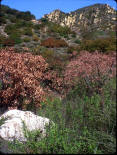
Chaparral vegetation in the Santa Monica Mountains near Los Angeles neighbors one of the largest metropolitan areas in the United States and occupies one of the most valuable water sheds in California. Chaparral deters soil erosion, maintains slope stability, furnishes browse and cover for wildlife, and provides aesthetic and recreational value. While research has previously focused on the response of chaparral to fire and water stress, there is growing evidence that low temperature tolerance is an important factor underlying chaparral distribution and abundance. Based on frequency, subzero temperature episodes may be as important to chaparral communitites as fires and drought. Loss in productivity, injury, and in some cases death of native plants have been observed after freezing events. Seedlings may be particulary vulnerable as the reduction of plant cover after fire can expose them to potentially lethal radiation freezes at night. The combination of a steep gradient in minimum temperatures (-3 C on the coast to -20 C inland) and recently burned sites in southern California provide an unsurpassed opportunity to examine the hypotheses that seedlings are more vulnerable to low temperature damage than adults, freezing and the amount of freezing-induced embolism is related to both wood structure and rate of thaw. The results will have implications for land use management, such as mitigation of fire-burned areas in southern California, for revegetation projects by theUnited States Forestry Service and the Natrual Resources Conservation Service, and for citrus farmers that use temperature sensitive species of chaparral as indicators for suitable growing location
Selected references (* denotes undergraduate student):
- Davis, S.D., A. M. *Helms, M.S. *Heffner, A.R. *Shaver, A.C. *Deroulet, N.L. *Stasiak, S.M. *Vaughn, C.B. *Leake, H.D. *Lee and E.T. *Sayegh. 2007. Chaparral Zonation in the Santa Monica Mountains:The Influence of Freezing Temperatures. Fremontia 35:12-15.
- Davis, S.D., R. B. Pratt, F.W. Ewers and J.L. Jacobsen. 2007. Freezing tolerance impacts chaparral species distribution in the Santa Monica Mountains. In: Flora and Ecology of Santa Monica Mountains: Proceedings of 32nd Annual Southern California Botanists Symposium. D. A. Knapp (Ed.). Page 159-172. Southern California Botanists Special Publication No. 4, Fullerton, California.
- Davis, S.D., F.W. Ewers, R.B. Pratt, P.L. Brown, T.J. Bowen 2005. Interactive effects of freezing and drought on long distance transport: A case study for chaparral shrubs of California. In: Vascular Transport in Plants, N. Michele Holbrook, Maciej A. Zwieniecki (Ed.). Elsevier/AP co-imprint, Oxford, 20:425-435.
- Pratt, R.B., F.W. Ewers, M.C. Lawson, A.L. *Jacobsen, M. *Brediger, and S.D. Davis. 2005. Mechanisms for tolerating freeze-thaw stress of two evergreen chaparral species: Rhus ovata and Malosma laurina (Anacardiaceae). American Journal of Botany 92:1102-1113.
- Ewers, F.W., M.C. Lawson, *T.J. Bowen and S.D. Davis. 2003. Freeze/thaw stress in Ceanothus of southern California chaparral. Oecologia (Berlin) 136:213-219.
- Davis, S.D., J.S. Sperry, and U.G. Hacke. 1999. The relationship between xylem conduit diameter and cavitation caused by freeze-thaw events. American Journal of Botany. 86:1367-1372
- *Boorse, G.C., F.W. Ewers, and S.D. Davis. 1998. Differential response of chaparral shrubs to below freezing temperatures. American Journal of Botany. 85:1224-1230.
- *Boorse, G.C., *T.L. Gartman, *A.C. Meyer, F.W. Ewers, and S.D. Davis. 1998. Comparative methods of estimating freezing temperatures and freezing injury in leaves of chaparral shrubs. International Journal of Plant Science. 159:513-521.
- *Langan, S. J., F.W. Ewers, and S.D. Davis. 1997. Differential susceptibility to xylem embolism caused by freezing and water stress in two species of chaparral shrubs. Plant Cell and Environment. 20:425-437.
- Tyree, M.T., S.D. Davis and H. Cochard. 1994. Biophysical Perspectives on xylem evolution: is there a tradeoff of hydraulic efficiency for vulnerability to dysfunction? International Association of Wood Anatomists. 15:335-360.
Biomechanics:
It has recently been discovered that resistance of chaparral xylem to cavitation (by water stress) is correlated with the mechanical strength of woody stems. This correlation occurs at two levels -- the cellular level and the whole branch level. At the cellular level it has been found that with the greater resistance of xylem conduits to cavitation the greater their implosion resistance (Hacke et al. 2001). At the whole branch level it has been found that woody stems most resistant to cavitation are also most resistant to breakage (Wagner et al. 1998; Jacobsen et al. 2005). Similar relationships may hold for leaves (Balsamo et al. 2003).
Selected publications (* denotes undergraduate student)
- Pratt, R.B., A.L. *Jacobsen, K. *Golgotiu, J.S. Sperry, F.W. Ewers, S.D. Davis. 2007. Life history type and water stress tolerance in nine California chaparral species (Rhamnaceae). Ecological Monographs. 77:239-253.
- Pratt, R.B., A.L. *Jacobsen, F.W. Ewers, and S.D. Davis. 2007. Relationships among xylem transport, biomechanics and storage in stems and roots of nine Rhamnaceae species of the California chaparral. New Phytologist 74:7787-798.
- Jacobsen, A.L., L. Agenbag, K.J. Esler, R.B. Pratt, F.W. Ewers, S.D. Davis. 2007. Xylem density, biomechanics and anatomical traits correlate with water stress in 17 evergreen shrub species of the Mediterranean-type climate region of South Africa. Journal of Ecology. 95:171-183.
- *Jacobsen, A.L., R. Brandon Pratt, F.W. Ewers, and S.D. Davis. 2007. Cavitation resistance among twenty-six chaparral species of southern California. Ecological Monographs. 77:99-115.
- *Jacobsen, A.L., F.W. Ewers, R.B. Pratt, W.A. Paddock III, S.D. Davis. 2005. Do xylem fibers affect vessel cavitation resistance? Plant Physiology. 139:546-556.
- Balsamo, R. A., A. M. Bauer, S. D. Davis and B. M. Rice*. 2003. Leaf biomechanics, morphology and anatomy of the deciduous mesophyte Prunus serrulata and the evergreen sclerophyllous shrub Heteromeles arbutifolia. American Journal of Botany. 90:72-77
- Hacke, U.G., J.S. Sperry, W. T. Pockman, S.D. Davis, K.A. McCulloh. 2001. Trends in wood density and structure are linked to prevention of xylem implosion by negative pressure. Oecologia. 126:457-461
- *Wagner, K.R., F. W. Ewers, and S.D. Davis. 1998. Tradeoff between hydraulic efficiency and mechanical strength in the stems of four co-occurring species of chaparral shrubs. Oecologia. 117:53-62